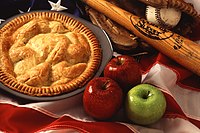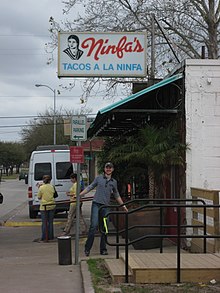
Tex-Mex cuisine is a regional American cuisine that derives from the culinary creations of Tejano people. It has spread from border states such as Texas and others in the Southwestern United States to the rest of the country. It is a subtype of Southwestern cuisine found in the American Southwest.

A fajita, in Tex-Mex cuisine, is any stripped grilled meat, optionally served with stripped peppers and onions usually served on a flour or corn tortilla. The term originally referred to skirt steak, the cut of beef first used in the dish. Popular alternatives to skirt steak include chicken and other cuts of beef, as well as vegetables instead of meat. In restaurants, the meat is usually cooked with onions and bell peppers. Popular condiments include shredded lettuce, sour cream, guacamole, salsa, pico de gallo, shredded cheese, refried beans, and diced tomatoes. "Tacos de arrachera" is applied to the northern Mexican variant of the dish.
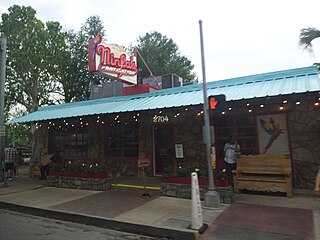
The Original Ninfa's on Navigation is a popular Mexican restaurant located at 2704 Navigation Boulevard in Houston, Texas. The restaurant serves both Tex-Mex and Mexican cuisine. The Original Ninfa's was started by Ninfa Rodríguez Laurenzo, a Mexican-American woman, in a tortilla factory. Ninfa Laurenzo became a full-time restaurateur and the tortilla factory closed. Mama Ninfa is widely credited with popularizing the fajita among Houstonians.
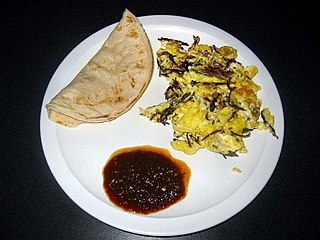
Machacado con huevo, Machaca con huevo, or Huevos con machaca is a dish consisting of shredded dry beef that is scrambled with eggs. Its name means "shredded with eggs" in Spanish. The shredded dry beef, carne seca or "machaca", is said to have originated in the town of Ciénega de Flores, about an hour's drive north of Monterrey, Mexico. The early settlers in the area air-cured beef so that it would be preserved.
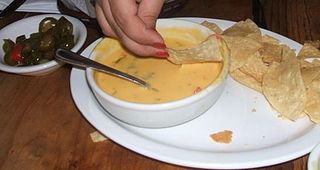
Chile con queso, sometimes simply called queso, is an appetizer or side dish of melted cheese and chili peppers, typically served in Tex-Mex restaurants as a dip for tortilla chips.

On The Border Mexican Grill & Cantina is a chain of Tex-Mex food casual dining restaurants located in the United States and South Korea. The chain and brand name is owned by Argonne Capital Group.
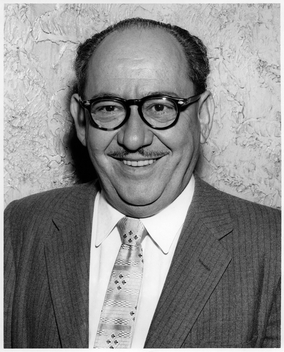
Felix Tijerina (1905–1965) was a Mexican-American restaurateur, activist, and philanthropist in Houston, Texas. He served as the 25th president of the League of United Latin American Citizens.

Maria Ninfa Rodriguez Laurenzo, born with the family name Rodriguez, was an American restaurateur from Houston, Texas, who founded the restaurant Ninfa's. Laurenzo started out running a single taco stand in Houston, Texas.

Texas Barbecue refers to methods of preparation for barbecue unique to Texan cuisine. Beef brisket, pork ribs, and sausage are among the most commonly known dishes. The term can also include side dishes that are traditionally served alongside the smoked meats.

The city of Houston has significant populations of Mexican Americans, Mexican immigrants, and Mexican citizen expatriates. Houston residents of Mexican origin make up the oldest Hispanic ethnic group in Houston, and Jessi Elana Aaron and José Esteban Hernández, authors of "Quantitative evidence for contact-induced accommodation: Shifts in /s/ reduction patterns in Salvadoran Spanish in Houston," referring to another large Latino group in Houston, stated that as of 2007 it was the most "well-established" Hispanophone ethnic group there. Houston is the third city for Mexican immigrants after Chicago and Los Angeles.
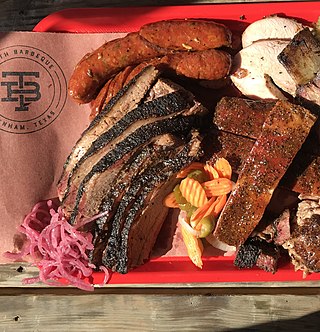
Texan cuisine is the food associated with the Southern U.S. state of Texas, including its native Southwestern cuisine influenced Tex-Mex foods. Texas is a large state, and its cuisine has been influenced by a wide range of cultures, including Tejano/Mexican, Native American, Creole/Cajun, African-American, German, Czech, Southern and other European American groups.

This article discusses the various cuisines in Houston, Texas.
Maggie Rita's Tex-Mex Grill & Bar is a Tex-Mex restaurant in Houston. For several years, Maggie Rita's was a restaurant chain with a license co-owned by Carlos Mencia and Santiago Moreno of Suave Restaurant. In January 2013, Moreno closed the last two locations they owned. Tony Shannard owns the only remaining Maggie Rita's restaurant, which is situated in Houston's JPMorgan Chase Tower.

Molina's Cantina is a Tex-Mex restaurant chain in Houston, Texas. As of 2022, Molina's is the oldest still-operating Tex-Mex restaurant in Houston.

Robb Walsh is an American food writer, cookbook author, and restaurant owner who divides his time between Galway Bay, Ireland, and Galveston, Texas. He is a former commentator on National Public Radio's Weekend Edition, Sunday; former restaurant critic at the Houston Press ; former editor-in-chief of Chile Pepper Magazine ; former food columnist for Natural History magazine, and three-time winner of the James Beard Award. He currently writes about food for magazines such as Houstonia and Texas Highways, and websites such as First We Feast. He was a partner and co-founder of the former El Real Tex-Mex Cafe in Houston's Montrose neighborhood.

Esparza's Tex Mex Cafe, or simply Esparza's, was a Tex-Mex restaurant in Portland, Oregon, in the United States. Opened by Martha and Joe Esparza in 1990, the restaurant operated for more than 24 years before closing in January 2014. Its unusual menu included buffalo tostadas, ground ostrich and nopalitos, several varieties of tongue, beef brisket, and more traditional options such as enchiladas, quesadillas, tacos and tamales. Esparza's was one of Portland's most popular restaurants during the 1990s and was named "Restaurant of the Year" by The Oregonian in 1992.
Josef Centeno is an American chef, restaurateur and cookbook author who specializes in Tex-Mex cuisine. He was nominated for a James Beard award for Best Chef in February 2020.
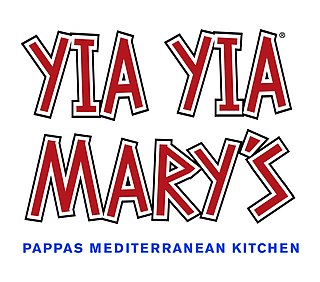
Yia Yia Mary's was a Greek restaurant with two locations in Houston, in the U.S. state of Texas. Pappas Restaurants opened the Uptown Houston restaurant in 2004, and second Yia Yia Mary's began operating at William P. Hobby Airport in 2015. The restaurants served Greek cuisine including seafood and received a generally positive reception. Both locations closed in 2020, during the COVID-19 pandemic.

Jackalope Tex-Mex and Cantina, or simply Jackalope, is a restaurant in Columbia City, Seattle, in the U.S. state of Washington. Established by co-owners Jack Timmons and Graham Ayers in 2021, the restaurant serves Tex-Mex and Mexican cuisine, and has garnered a positive reception.
